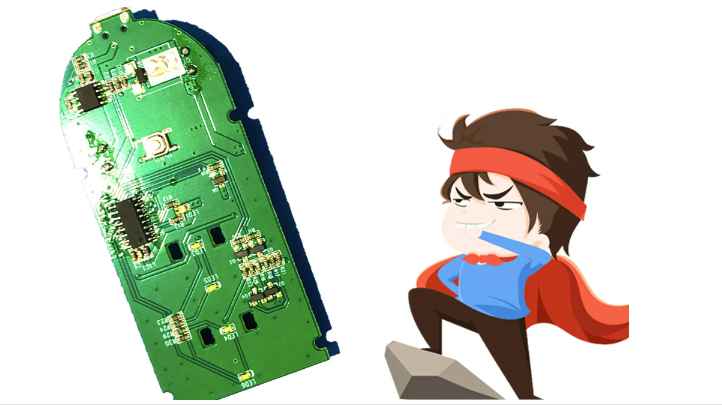
1. Hole wall coating cavity caused by PTH
The holes in the pore-wall coating caused by PTH are mainly spot-like or annular holes, and the specific reasons are as follows:
Discussion on the cause and countermeasure of PCB holewall coating cavity
(1) Copper content, sodium hydroxide and formaldehyde concentration of copper cylinder
The concentration of solution in the copper tank is the first thing to consider. Generally speaking, the copper content, sodium hydroxide and formaldehyde concentration is proportional, when any of the content is less than 10% of the standard value will destroy the balance of the chemical reaction, resulting in poor deposition of chemical copper, the appearance of spot-like holes. So the priority is to adjust the copper cylinder of the potion parameters.
(2) the temperature of the tank
The temperature of the tank also has an important effect on the activity of the solution. There are generally temperature requirements in each solution, some of which are strictly controlled. So the temperature of the tank should also be paid attention to at any time.
(3) Control of activation fluid
Low tin ion will cause the decomposition of colloidal palladium and affect the adsorption of palladium, but as long as the activation solution is added regularly, it will not cause big problems. The key point of the control of the activation solution is not to stir with air. The oxygen in the air will oxidize the tin bivalent ion. At the same time, no water can enter, which will cause the hydrolysis of SnCl2.
(4) cleaning temperature
The cleaning temperature is often ignored. The best temperature for cleaning is above 20℃. If it is below 15℃, the cleaning effect will be affected. In winter, the water temperature can get very cold, especially in the north. Due to the low temperature of washing, the temperature of the board will become very low after cleaning. The temperature of the board cannot rise immediately after entering the copper cylinder, which will affect the effect of deposition because the golden time of copper deposition is missed. So in the place where the ambient temperature is low, you should also pay attention to the temperature of the cleaning water.

(5) The use temperature, concentration and time of the filling agent
The temperature of the liquid medicine has strict requirements. Too high temperature will cause the decomposition of the pore-filling agent, make the concentration of the pore-filling agent lower, and affect the effect of the whole hole. Its obvious feature is the appearance of dotted holes in the glass fiber cloth in the hole. Only when the temperature, concentration and time of the liquid are properly coordinated, can we get good effect of the whole hole and save the cost at the same time. The concentration of copper ions accumulating in liquid medicine must also be strictly controlled.
(6) The use temperature, concentration and time of reducing agent
The role of reduction is to remove the residual potassium manganate and permanganate after drilling. The loss of relevant parameters of the liquid medicine will affect its effect, and its obvious feature is that the resin in the hole appears punctate cavity.
(7) Oscillators and wobbles
The loss of control of oscillators and oscillations will result in annular cavities, which are mainly due to the failure of air bubbles to be removed from the holes, most notably the orifice plates with the ratio of height to diameter. Its obvious characteristics are the holes in the hole symmetry, and the hole in the copper part of the copper thickness is normal, graphic electroplating (secondary copper) coating (primary copper).
2. Hole wall coating hole caused by pattern transfer
The holes in the hole wall coating caused by pattern transfer are mainly holes in the hole ring and hole ring, the specific reasons are as follows:
(1) pretreatment brush plate
The pressure of the brush plate is too large, the copper layer of the whole plate and the copper layer of the PTH orifice is brushed off, so that the following graphic plating cannot be plated with copper, resulting in the orifice annular cavity. The obvious feature is that the copper layer of the orifice becomes thinner and the graphic electroplating coating covers the whole plate coating. So by doing the abrasion test, control the brush pressure.
(2) orifice residual glue
It is very important to control the process parameters in the graphic transfer process, because the pretreatment drying is poor, the improper temperature and pressure of the film will cause the residual glue at the edge of the orifice and lead to the annular cavity of the orifice. Its obvious characteristics are that the thickness of the copper layer in the hole is normal, the annular cavity at the single or double-sided orifice is extended to the welding pad, the fault edge is obviously etched traces, the graphic electroplating did not wrap the whole plate.
(3) pretreatment micro-etching
The amount of micro-corrosion before treatment should be strictly controlled, especially the rework times of dry film plate. The main reason is that the thickness of the coating is thin due to the problem of electroplating uniformity in the middle of the hole. Excessive rework will cause the thinning of the copper layer in the hole of the whole plate, and eventually produce a ring without copper in the middle of the hole. The obvious feature is that the full plate coating becomes thinner in the hole, and the graphic coating covers the full plate coating (see Figure 4).
3. Hole wall coating hole caused by graphic electroplating
(1) graphic electroplating micro-etching
The amount of micro-etching in graphic electroplating should be strictly controlled, and the defects produced are basically the same as the micro-etching in dry film pretreatment. When the hole wall will be large area without copper, the whole plate thickness on the surface is obviously thin. Therefore, DOE experiment is the best way to optimize the process parameters to measure the micro-corrosion rate regularly.
(2) Tin plating (lead tin) poor dispersion
Due to the poor performance of the solution or insufficient swing factors such as insufficient tin plating coating thickness, in the back of the film and alkaline etching the hole in the middle of the tin layer and copper layer corrosion, resulting in annular cavity. The obvious features are that the copper layer in the hole is of normal thickness, the fault edge is obviously etched, and the graphic electroplating does not cover the entire plate (see Figure 5). In view of this situation, you can add some tinning varnish in acid leaching before tin plating, can increase the wettability of the board, at the same time increase the amplitude of swing.
4. Conclusion
There are many factors causing the coating cavity, the most common is PTH coating cavity, by controlling the relevant process parameters of the potion can effectively reduce the generation of PTH coating cavity. But other factors can not be ignored, only through careful observation, understand the cause of the coating cavity and the characteristics of defects, in order to timely and effectively solve the problem, maintain the quality of products.






